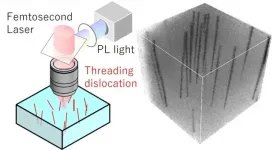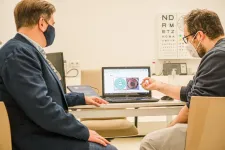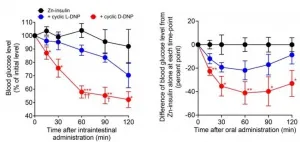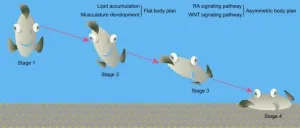Results of study could be biggest rehab advance in decades for patients after stroke
Patients who incorporated vagus nerve simulation during physical or occupational therapy showed 2-3 times the improvement in arm and hand function
2021-04-26
(Press-News.org) Results of a study co-authored by MGH Institute of Health Professions researcher Teresa Kimberley, PhD, PT, have the potential to be one of the most impressive advances in decades to help improve the lives of patients who have had a stroke with resulting arm weakness.
In an article published April 22 in The Lancet, "Vagus Nerve Stimulation Paired with Rehabilitation for Upper Limb Motor Function After Ischaemic Stroke (VNS-REHAB): A Randomised, Blinded, Pivotal, Device Trial," the study reports that patients who incorporated vagus nerve stimulation during physical or occupational therapy showed 2 to 3 times the improvement in arm and hand function compared to those who received intense rehabilitation with sham stimulation.
"How to optimize recovery after a stroke has been studied for decades, but there has been little shown to dramatically improve peoples' daily lives," said Dr. Kimberley, who is a senior author on both the pilot and pivotal vagus nerve stimulation studies, directs the MGH Institute's Brain Recovery Lab, and is a professor of physical therapy at the Boston health sciences graduate school. "Using vagus nerve stimulation paired with repetitions of therapeutic movement appears to help 'rewire' the brain to strengthen the brain pathways needed to perform the everyday tasks people want to be able to do. This may be an important new tool to improve people's lives."
The 108 patient participants in the study were implanted with a VNS system called Vivistim, produced by MicroTransponder, Inc., an Austin-based, privately held medical device development company, which funded the study. During six weeks of in-clinic therapy followed by three months of home-based therapy, participants received a stimulation of the vagus nerve via a small electrical pulse from a cuff wrapped around the nerve, powered by a unit implanted under the skin near the clavicle. This pulse, delivered during their rehabilitation exercises, essentially helps the brain relearn how to perform tasks such as carrying a grocery bag, using a fork, or casting a fishing line.
Participants in the trial ranged from nine months to 10 years post-stroke. With 50%-60% of the 658,000 yearly stroke survivors in the United States being left with upper extremity motor deficits that persist for months or years, the findings suggest they may be able to improve function and perform some everyday tasks once again.
The study reported there were no unexpected or serious adverse events associated with the Vivistim system.
Kimberley, who has an appointment as research staff at Massachusetts General Hospital Department of Neurology and as core faculty in the hospital's Center for Neurotechnology and Neurorecovery, acknowledges the large team effort associated with running this trial, which would not have been possible without the multidisciplinary coordination provided by CNTR and the collaborative effort between the MGH Institute, MGH Neurology, and MGH Neurosurgery.
"We are only beginning to understand how to best stimulate the brain to regain function," said Kimberley, who has researched various types of brain stimulation for over 15 years. "Rehabilitation has always been the key to maximizing recovery after a stroke. Brain stimulation, including methods such as vagus nerve stimulation, may make rehabilitation activity even more impactful and lead to greater gains than we previously thought possible for people with neurologic disorders."
INFORMATION:
The Vivistim system currently is being reviewed by the U.S. Food and Drug Administration and by regulatory agencies in the United Kingdom and European Union.
Dr. Kimberley can be reached at 612-382-8036 or tkimberley@mghihp.edu.
Read The Lancet article.
Read The Lancet editorial.
[Attachments] See images for this press release:
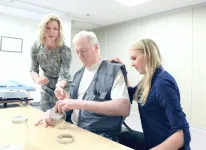
ELSE PRESS RELEASES FROM THIS DATE:
2021-04-26
With climate change looming, what must people hear to convince them to change their ways to stop harming the environment? A new Johns Hopkins University study finds stories to be significantly more motivating than scientific facts-- at least for some people.
After hearing a compelling pollution-related story in which a man died, the average person paid more for green products than after having heard scientific facts about water pollution. But the average person in the study was a Democrat. Republicans paid less after hearing the story rather than the simple facts.
The findings, published this week in the journal ...
2021-04-26
Humans have been breeding plants for their economic value for thousands of years. Traditionally, plant breeding techniques included cumbersome and time-consuming techniques like grafting and hybridization to enhance traits of economic value like disease resistance and high nutrition content. Now, with the ability to edit plant DNA using revolutionary gene-editing tools, particularly the CRISPR-Cas9 system, it is possible to enhance traits of economic value in plants easily and more efficiently than by using traditional techniques. But for that, it is necessary to sequence whole ...
2021-04-26
Osaka - Gallium nitride (GaN) is a semiconductor material whose wide band gap may one day lead to it superseding silicon in electronics applications. It is therefore important to have GaN characterization techniques that are able to support the development of GaN devices. Researchers at Osaka University have reported a nondestructive method for characterizing the crystalline quality of GaN. Their findings were published in Applied Physics Express.
GaN power switching devices offer numerous advantages including high-speed switching, high-power operation, low on-resistance, and high breakdown voltage. To take advantage of these properties, the defect density of GaN crystals must be low.
Threading dislocations ...
2021-04-26
The various methods that Netflix employs when premiering its content favour the international success of original local productions and, at the same time, act as a safety net for these films in an audiovisual industry in constant evolution.
A study conducted by Universitat Oberta de Catalunya (UOC) researchers Antoni Roig, Judith Clares and Jordi Sánchez, published in the open access journal Communication & Society, has analysed the various systems and schedules implemented by the American entertainment platform in recent years in relation to its original feature films, which have allowed it to become the leader in the distribution of on-demand audiovisual content.
According to the authors, the approaches adopted by Netflix form part of a global expansion plan to consolidate ...
2021-04-26
A new study has found Australia's government-owned airports could produce enough electricity to power 136,000 homes, if they had large-scale rooftop solar systems installed.
Researchers at RMIT University compared electricity generated by residential solar panels in a regional Australian city to the potential green energy production of 21 leased federal airports.
They found if large-scale solar panels were installed at the airports, they would generate 10 times more electricity than the city's 17,000 residential panels, while offsetting 151.6 kilotons of greenhouse gasses annually.
Researcher Dr Chayn Sun said the analysis showed the value ...
2021-04-26
As a result of the work of five years of research, they have created the first trifocal corneal inlay that is also fully transparent. Such an inlay would allow good eyesight to presbyopic people of objects located at several distances: far, intermediate (computer, mobile devices) and near. Their work has been published in Nature group's Scientific Reports journal.
"This inlay could be an alternative for those suffering from presbyopia who would rather not use glasses or contact lenses. Furthermore, it would be fully compatible with laser refractive surgery in myopic and hyperopic patients, as well as possible subsequent cataract interventions. We are suggesting something totally new that is also not ...
2021-04-26
Researchers from Kumamoto University, Japan have found that DNP peptide, a small intestine-permeable cyclic peptide originally used as an insulin additive to improve absorption into the small intestinal, lowers blood glucose levels in mice. They also found that insulin can be administered orally by simply adding D-form DNP peptide (D-DNP) peptide to injectable insulin used in clinical practice. This study is expected to provide a basis for the development of oral insulin using DNP peptides.
Insulin therapy by self-injected insulin is currently the best way to control ...
2021-04-26
Narcolepsy with cataplexy, or narcolepsy type 1 (NT1), is a rare and chronic neurological disease whose prevalence increased in children and adolescents after the administration of Pandemrix swine flu vaccine in 2009-2010. It is an autoimmune disease to which a specific inherited tissue type (HLA-DQB1*0602) predisposes people.
The disease mechanism of NT1 was investigated in a collaborative study carried out by PhD student Arja Vuorela and university researcher Dr. Tobias Freitag, working in the research groups of Prof. Outi Vaarala and Prof. Seppo Meri. The study analyzed the cell-mediated immune response targeting ...
2021-04-26
The colonization of the seafloor is one of the most important events in evolutionary history, leading to an explosive radiation and large-scale morphological diversification of marine phyla. Flatfishes are one of the most successful groups of seafloor colonizers and have evolved the most specialized body plan (i.e., flat and asymmetrical) among the teleosts. However, the origin and formation mechanism of the peculiar morphology of flatfishes had long been unclear.
Now, researchers from the Kunming Institute of Zoology of the Chinese Academy of Sciences ...
2021-04-26
Announcing a new article publication for BIO Integration journal. In this mini review article the authors Meiyu Qiu and Pei Li from Korea Advanced Institute of Science and Technology (KAIST), Daejeon, Republic of Korea summarize CRISPR/Cas-based Diagnostics and Gene Therapy.
Clustered regularly interspaced short palindromic repeats (CRISPR) technology, an easy, rapid, cost-effective, and precise gene-editing technique, has revolutionized diagnostics and gene therapy. Fast and accurate diagnosis of diseases is essential for point-of-care-testing (POCT) and specialized medical institutes. The CRISPR-associated (Cas) proteins system shed light on the new diagnostics methods at point-of-care (POC) owning to its advantages. In addition, CRISPR/Cas-based gene-editing ...
LAST 30 PRESS RELEASES:
[Press-News.org] Results of study could be biggest rehab advance in decades for patients after stroke
Patients who incorporated vagus nerve simulation during physical or occupational therapy showed 2-3 times the improvement in arm and hand function



